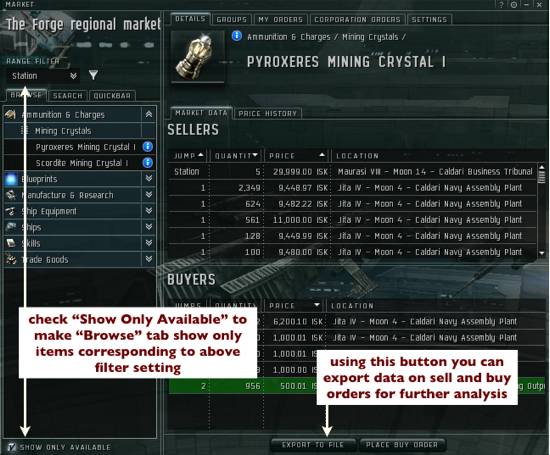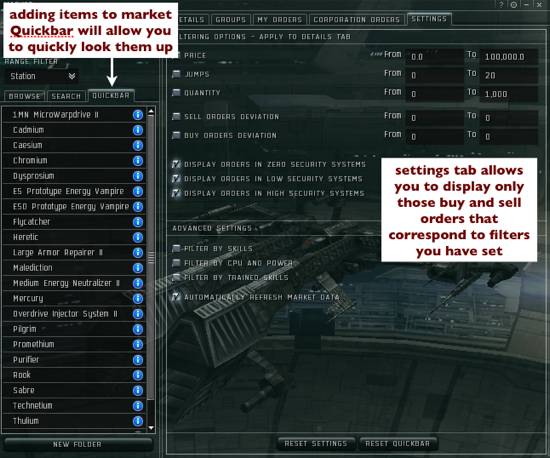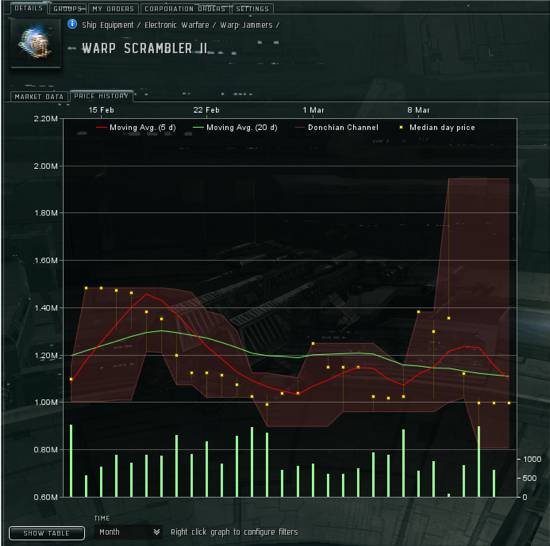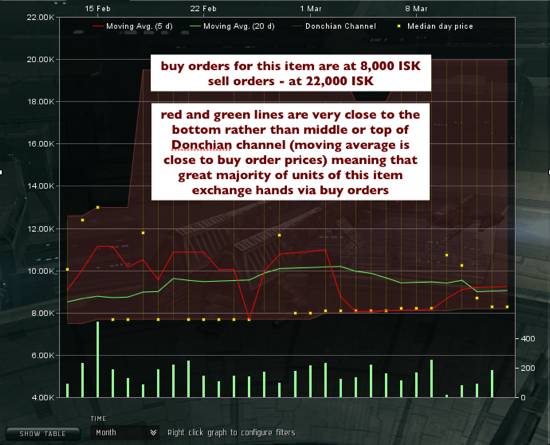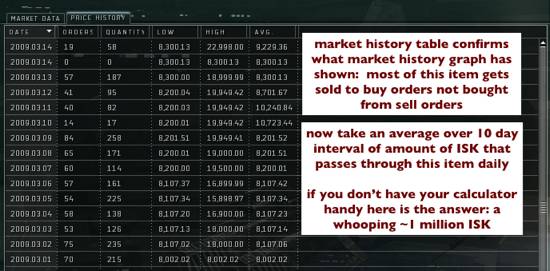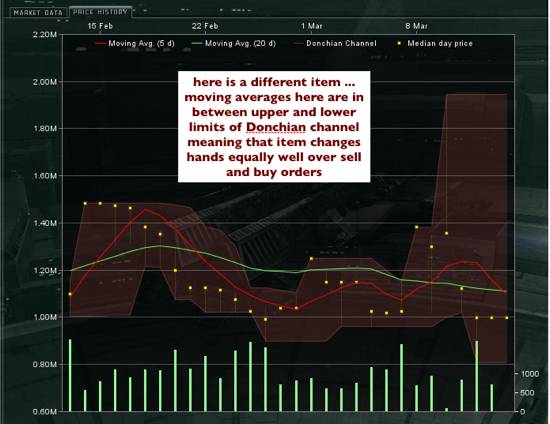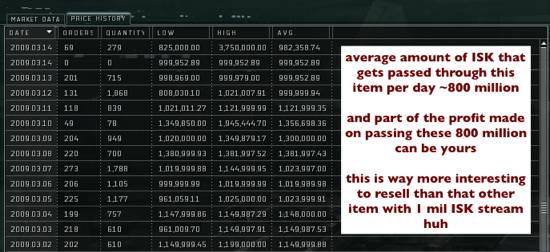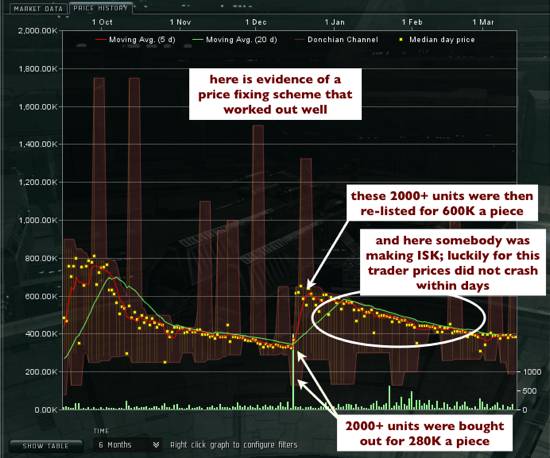The Basics of Trading
"What is best way to trade? Buy low and sell high, of course!" - Anonymous Trader
"Every [trader] needs to master three essential components of trading; a sound individual psychology, a logical trading system, and good money management" - A. Elder
Contents
Introduction: Why Trade?
Trading is one of the highest income activities in EVE. All ISK-making activities in EVE naturally have a cap on their hourly income. For activities involving harvesting game's resources, such as NPCing and mining, this cap is typically somewhere in the range of 10-30 million ISK per hour. Trading obviously has its own limit, as you cannot generate unlimited ISK/hour, however it does offer a much higher cap per same time and effort invested when compared to other ISK-generating activities the game has to offer. It is also one of the less time demanding occupations in EVE and can be made as risky or low risk as you would like it to be. And what's more, trading generates ISK even when you are not playing the game. You can be gone on vacation for a week and ISK will be slowly seeping into your wallet.
Given the above, why doesn't everybody in EVE trade then? The answer is simple: not all players find it fun and not all players become successful at it. Being a successful trader who finds trading to be continuously engaging and interesting requires a certain mindset. Some players might find mining relaxing, while others find it excruciatingly boring and frustrating, and similarly not everyone enjoys trading. As you start experimenting with it, keep in mind that it is only a good way of generating ISK for as long as you're having fun doing it.
"Buy Low, Sell High"
Every beginning trader seeking advice on how to trade the best will eventually encounter a response that goes something like "buy low, sell high". However, this response only springs more questions to mind. Buy what? Sell where? What is low? And what is high?
Amateur traders may seek answers to these questions from their friends, corpmates, or post make threads in market forums. My advice: don't. It is highly unlikely that a successful trader will reveal their trading secrets to you, ultimately turning you into a competitor. Trading is unlike other forms of generating ISK in that it can be done completely solo. Unlike mining, running missions, maintaining a POS network, exploration, or ratting in 0.0 space, trading offers very little incentives for group play. As such, the mindset of a regular trader is that everyone swims through the murky waters of market on his or her own. In summary, it is highly unlikely that you will receive good advice from other players on trading beyond the generic and/or outdated ones.
If you would like to find some worthwhile opportunities to make ISK trading, you have do the homework yourself. There is no easy way around it. Spend a few hours doing market research and read guides posted on the subject. Take a peek at EVE's market forum, try to pick up some tips and hints from success stories of other traders. The process of buying, selling, and hauling goods is not very difficult. It is seeing opportunities to buy/sell at a good profit that is an art.
How Can I Start Trading?
There are only two prerequisites to trading:
- A investment sum.
In general, 100 mil ISK is a sufficient amount to get you started. In trade, money makes money. The more available capital you have to invest, the more ISK you have the potential to make. Most traders get this initial investment capital from other ISK-making activities in game. Trading with 20-30 million actually generates ISK slower than mining or missions, so it makes sense to make the initial capital by engaging in activities that pay more. Once you reach a certain level, your investment sum will start generating you more ISK than you can earn with ratting or mining.
- A character with at least 30 open buy/sell orders.
DO NOT train your combat main to do this carebear task. Otherwise you'll be clone jumping to empire several time a week to update orders, which means you will be out of gangs and out of pvp. If corporation gets a war declaration your main will also not be able to do any hauling tasks that might be required for your trading. Instead, roll another character on your account, give it plenty of Charisma, Memory, and Willpower, then plug in the following skills:
- Trade: +4 open buy/sell orders per level
- Retail: +8 open buy/sell orders per level
- Accounting: -10% to transaction tax per level
- Broker Relations: -5% to broker fees per level
- Contracting: +4 open contracts per level
Optional:
- Marketing: allows to sell items remotely, each level extends range at which you can sell items
- Daytrading: allows to modify orders remotely, each level extends range at which you can alter orders
- Procurement: allows to set up buy orders remotely, each level extends range at which you can place orders
- Visibility: extends effective range of remote buy orders (for local buy order you can set whatever range you wish from station to region-wide)
- Margin Trading: each level of skill reduces the percentage of ISK placed in market escrow when entering buy orders
- Wholesale: + 16 open buy/sell orders per level, requires Retail V
- Tycoon: + 32 open buy/sell orders per level, required Wholesale V
- Hauler skills: Racial Frigate III, Spaceship Command III, Industrial II, Hull Upgrades II, Shield Upgrades I
Spend about 1-2 weeks training Trade IV, Retail IV, Accounting III, Broker Relations III, Contracting I and may be II-III levels on other skills and your alt will be set to make you ISK for the rest of the year.
Once you have fulfilled both of these prerequisites, think of Nike's slogan Just do it. The best way to learn something is by experience. This is true for pvp and it is true for trading. Do a bit of homework then just start experimenting. Eventually you will see certain patterns and figure out what makes you the most ISK.
What can I trade?
Practically anything can be bought at a low price and resold at higher value, but your play time is limited and you have to pick what exactly it is you want to be trading. Several considerations have to go into this. How often do you plan to come online and change orders? Obviously trading in Warp Disruptor II's you will be often outbid while if you trade in Magnetic Plating II you will not have to modify your order so often. Do you want to devote any time to hauling? If so you might look into trading items that fetch a good price in another region. Do you want to make a lot of ISK in the shortest amount of time? Well of course you do! But so does everybody else, and as such it is a competition between you and other traders seeing opportunities that will make the most ISK in shortest period of time.
Here are some common ways to trade:
- Trading NPC goods. This is the most basic method of trading that many newbies start out with. NPC trade goods sell in the "Trade Goods" section of the market. NPCs set up sell orders and buy orders for these at certain price differences that can be exploited to make profit. The down side of this type of trading is that it requires hauling stuff often between two different regions, which is time consuming. The price difference also slowly decreases as more and more players start using the route. Eventually it gets extinguished and those who have been using it have to find a new ones to continue making ISK. In empire this activity is very low pay generating at most may be 10 million ISK per hour. However the more risky the route is, the more profitable it can be: Making 2.2 Bil ISK a Day via NPC Route
- Trading modules. If you have ever lived in a region where NPCs do not drop the racial items needed to fit out your ships this way of trading is quite apparent. While T1 non-named and T2 modules can be produced anywhere, named items are lacking in regions where NPCs don't drop them as loot. Their entire supply in these regions comes from traders importing them in and reselling them at a markup. You can also trade T1 and T2 modules between two trade hubs if you see there is a good discrepancy in prices. There are can be decent profits to be made if you haul your items to places where little or limited manufacturing takes place, such as lowsec or 0.0 stations. Modules can be successfully traded via buy/sell orders as well as private bulk orders from producers and inventors.
- Trading ships. Ships can be produced anywhere on site just like T1 non-named and T2 modules. Unlike modules, however, ships require significant investment in ISK, as one T1 cruiser hull already costs 4-6 million ISK on its own. Also unlike modules ships are rarely dropped to buy orders. Players prefer to blow them up either in PVP or in attempts to get their insurance payout. Ships are therefore best traded by establishing contacts with the producers who often don't want to bother with hauling them to trade hubs and then sitting there watching sell orders. For this you would need to own a freighter. In-station trading in ships is not profitable.
- Trading building materials. Building materials include things like common minerals and ores (tritanium, kernite, zydrine, etc.), raw moon materials and products of complex and simple reactions, capital ship construction components, blueprint originals and blueprint copies needed for the said production to happen, and invention-related materials such as datacores needed to generate T2 blueprints. If you would like to trade in building materials make sure you understand what they are used for.
- Trading POS fuel. EVE universe is hopelessly littered with POSes and each hour every single one of them consumes fuel. Those players who have no time or means to go to a major trade hub to purchase POS fuel will often pay a nice markup to have it readily available in vicinity. POS fuel gets consumed especially fast in places where territorial wars take place and POSs get killed on daily basis. In addition, each region features ice that can be refined into fuel that can fuel towers of the race that holds sovereignty in that space. So for example if you have a Gallente tower in Amarr space you won't be able to mine local ice belt for fuel. All local ice would refine into helium isotopes such that you would have to buy imported and marked-up oxygen isotopes.
- Trading implants, rigs, skill books, blueprints, GTCs, etc. Just like modules all of these items can be bought and resold at a higher prices in places where they are lacking and demand is high. There is a decent demand on rigs, implants, and skill books in 0.0 space. Blueprints originals and copies can be resold on contract system just like any other item.
- Trading via Sell Orders Forum. Anything being bought/sold over Sell Orders forum can be traded for a profit; sometimes some exceptionally good deals can be found there. The trick is being able to sift through all the information in the shortest period of time. It is usually the more experienced and advanced traders who know their prices who benefit from using this forum the most. Amateur traders can get quite lost among all the threads posted there.
- Trading through contracts. Contracts have replaced old escrow system in Revelations expansion. This system is an alternative system used for selling and buying items that cannot be sold on regular market, such as rigged ships, blueprint copies and researched originals, Cosmos, faction, and officer loot, and various items such as Apotheosis shuttles and snow ball launchers. Just like on regular market, there are certainly good deal that can be found on contracts. In general, however, contracts trade requires considerable investment because items sold over it are not cheap.
- Trading characters. Unlike other ways of trading this one requires input of real life money. When you sell a character, you have to pay 20 in fees in order to transfer it from one account to another. However, it is not much of an obstacle for those players who already sell game time codes for their ISK. With character trading it is possible for example to resell a char for 1 billion ISK profit thus paying just 20 for 1 billion ISK.
- Keep in mind that anything in EVE that has an ISK value can be traded for profit. If it is not listed here it does not mean that you cannot buy and resell it for more ISKs.
Where to Trade
There are many locations where you can do the "buy low, sell high" trick. The best way of learning pros and cons of each location is by experimenting.
- In-Station Trading. Perhaps one of the most common and laziest ways of trading. Using this approach, you don't have to undock or haul anything - just set up buy orders in same station that you are docked at and once goods drop resell them for a profit.
- Intra-Regional Trading. Trading within a region can be accomplished by setting up region-wide buy orders. Once a month items dropped to such buy order can be picked up and sold for profit at the main trading hub in region. You can do the hauling yourself, or alternatively outsource it via courier contracts to other players.
- Inter-Hub Trading. Trading hubs are systems with large populations of players who consume goods off the market at decent rate. Such systems can be mission running or factional warfare centers, or a populated 0.0 system. Most regions have one or more trading hubs and there is usually a price disparity between them such that goods can be traded between for a profit.
- Inter-Regional Trading. Each region offers some resources that other regions do not offer. The demand for these resources in those other regions fuels inter-regional trade. For example, you can buy hybrid weapons cheaper in Gallente space where rats drop them and resell them for more in Amarr space where rats drop only lasers. Common items to trade in this way include named modules, faction ammo, and pirate implants.
- Inter-Sec Trading. This is trade done between two systems of different security status, such as trading between highsec empire trading hub and a lowsec or nullsec system. In general, inhabitants of 0.0 and lowsec do not want to come out to highsec to ahop as this is accompanied with a certain measure of risk and it also takes them out of pvp gangs. Thus they will pay more to buy goods locally. This is especially true of 0.0 alliances that have several wardecs and that do not have good industrial backbone.
- Forum trading. Trading can be done completely over sale and buy orders forums in which case you'd just have to log into the game to complete the actual trade.
Tracking Income
As a trader, your income is ultimately your measure of success, but it is not just income that you have to consider - it is income per time you spent earning it. The income figure itself is pretty meaningless. Which of the two players do you think is more successful at trading: player A who spent 3 years earning 10 billion ISK or player B who spend one month making 500 million ISK? Obviously is the the player who spent one month making 500 million ISK because his income/time is greater even though the trader with 10 bil in his wallet is overall richer.
One of the greatest mistakes people make when trading is concentrating purely on the profit part and forgetting to consider time and effort they will have to put in to earn this profit. Say you have a module that you can purchase at 800K ISK and resell at rate of 100 units of per day at 10% profit in same station. Alternatively you can spend 10 minutes hauling these modules 10 jumps elsewhere and sell them for twice the original price but only 10 units of it will sell per day at this other location. 100 units selling at 90K profit and 10 units selling at 1.8 million ISK units will each generate you 9 million ISK per day. In the second case, however, you will spend 10 minutes hauling. Why? A lot of players when faced with similar options often pick the one that seems to generate most profit and forget to evaluate the time component. As a result they get stuck performing extra grind and don't make as much ISK as there is the potential to make. A successful trader will always concern with optimizing his or her time spent on making profit.
When you're thinking of ways to optimize your time trading, note that volume plays an important role here. Obviously the faster you can resell items, the greater your profit/ time will be. When you are looking through items to trade remember that your success in trading is not a simple function of difference between buy and sell orders. An item with lesser price discrepancy but greater volume traded each day has the potential to make you more ISK than an items with bigger discrepancy but lower trade volume.
Since income is direct measure of your success as a trader, many traders run 3rd party programs and compile their own spreadsheets to trace how much they are making. They analyze each item one by one to see how profitable it is and how much ISK/time it will add to their wallet. How technical you want to get here and how much time you would like to spend on this is completely up to you. A professional trader who plays EVE as trading space MMO will spend quite a bit of his or her gaming hours at this activity. However it is not necessary to be running 10+ spreadsheets to make decent ISK via trading. Personally I have not made much use of any 3rd party programs to track my orders or income. I relied on my intuition to optimize my trading and made an income that has been sufficient for me.
Here is a list of some of this software created by other players to help others in their capitalistic endeavors. Some of it is free to download, some isn't. Most of it requires your FULL character API key so make certain that you know what that means before you plug it in.
- EMMA - does a lot of things ... was free but not i think it comes at 100 mil ISK fee
- EVE-Tycoon - lets you help optimize the profit you can get from your orders
- EVETycoon - mainly deals with mineral market, refining and reprocessing
- EVE-Income - allows you to see rate at which items sell, major buyers, trade efficiency, and a few other things
- Market Master - software that tells you which of your orders have been outbid and need checking, not free
- MarketMuch - another program that analyzes what orders need to be updated, also not free
- NavBot - trade route finder
- Offline Wallet - wallet and transaction manager that can be used offline
- EVE Commander - another offline wallet manager
Market Window
Market window has several filters available as well as quick reference bar that will make it easier to you to look up market information. You can also export information on buy and sell orders within the region for any one item.
Analyzing Market Graphs
You have a limited number of buy/sell orders, perhaps a few hundred million of investment money, and a few hours of time that you can spend on trading each week. When doing market research, your priority is to find items that will make you the most profit per your limited time and resources. You can use software to import buy/sell order files and analyze them for you. Alternatively you can also do it by eye and use some basic math skills and your intuition to guide you.
In this task you will find the market history graph and tables are of great help. After all what better predictor is there of future behavior of certain items sold on market than evidence of their past behavior. I will go over a few basic examples and things you need to pay attention to when analyzing market history.
Here is a typical market history graph.
On it you can see several things:
- Moving averages. These are denoted by green and red lines.
- Donchian channel. This channel shows you the selling price range of an item. It does not encompass the entire range but only certain standard deviation away from the mean.
- Median price. Average is not always a good measure of price of an average item because it can be significantly influenced by outliers (items being sold or bought for very high or low prices), in which case median is a much better measure of the "average price". Median shows you the price of an item sold right in the middle of the entire volume sold per day, so if 123 units get sold medium would be price of 62nd unit.
- Volume. The small cyan bars at the bottom of the graph represent volume being sold with the actual volume axis being denoted on right hand side.
- Price. The left hand side y-axis shows the price of items being sold
- Time period. At the very bottom of the graph you can change the period of time for which you would like to see the graph.
You can also switch the graph to show you the price history table that contains the actual numbers that have been plugged in to create it.
Below is market history graph for our first item. Buy order for it stand at 8K ISK and sell orders stand at 22K ISK. Now if you switch over to its market history graph there are a few things you can observe. First thing that come to mind is that the moving averages are very close to the bottom of the Donchian channel. When the average is close to buy order price this means that most units that change hands do so by being dropped into buy orders rather than being bought over sell orders. The volume bars average out at approximately 250 units. So you will have no problem buying this item, but not a lot of it ends up back as sell orders.
What can be the reason for people buying out large volumes of this item and not reselling? The item is obviously getting consumed somehow. One way items get consumed is in pvp, but this is a crappy warp scrambler so it is unlikely to have such a good demand. Another explanation is that it is simply being reprocessed into minerals. For some items the combined sell price of minerals it reprocesses into is greater than the cost of the item itself. This would give us the pattern observed on the above graph.
Next lets use market history table to calculate profit that can be made from this item. This is done very simply by multiplying volume sold per day by average price. Sum this up for each day then take an average by dividing your sum by number of days.
Lets take a loot at another item now. Below is a market history graph showing sine wave-like moving averages. For the most part these averages are somewhere in the middle of Donchian channel. Average volume sold per day is close to 1000 units.
Now lets calculate the amount of ISK that exchanges hands through this item every day.
Price Fixing
In a price fixing scheme, you temporarily gain monopoly of an item to dictate its price. To do this you buy out entire stock of the item and relist it for a higher price. After this you have a period of time ranging from a few days to a few weeks until the price crashes back to what it was and you stop making profit. You goal in this time is to make as much ISK as you can (and isn't is always with trading?).
When you are attempting to price fix an item, there are several things to keep in mind:
- The sell orders for your stock need to appear natural. Nothing alerts the buyer more that some sort of price fixing is going on like a mega-sell order for a nice round price. Create several sell orders for the item and underbid yourself each time by 0.01 ISK.
- You should not set up just sell orders but also buy orders for this item to make sure you are the only one buying it. Eventually resellers of this item will notice your scheme and try to take advantage of it. You want to cut off their supply in the mean time via buy orders.
- Eventually producers/ratters will turn up on the market and set up their items for sale. Some of them will not for whatever reason take advantage of the scheme you set up and stubbornly list their stuff for original price. Buy it out and relist.
- Attempt to artificially raise buy order prices by fiercely competing with other buyers of this item. Hopefully a few of them will follow suite. Then when your price fixing scheme is coming to the end dump the remaining stock you have to their buy orders.
Price fixing schemes are risky enterprises and require a lot of attention for their duration. You will have to check your buy and sell orders several times a day, so obviously this is best done when you have a lot of free time to watch your orders. You can also lose money on this sort of exercise, or you can make a bil or two rather quickly.
Evidence of past price fixing schemes can be seen from market history graphs. If the scheme has just started, the graph might not yet have updated to reflect it. However you can simply compare average price of the item as shown on the graph to its price on sell orders. If the price is much higher it means the item might have just been price fixed or it is in very low supply. In any case, if you need to purchase it, it would be better to wait a few days for price to come down.
When you browse market graphs you will notice patterns alike the one pictured below:
